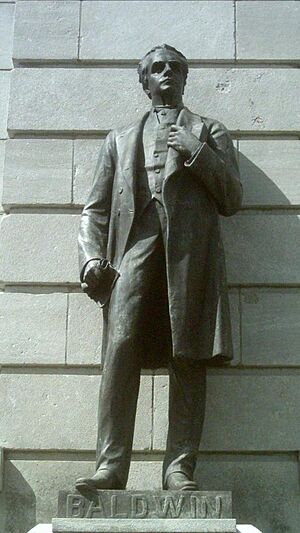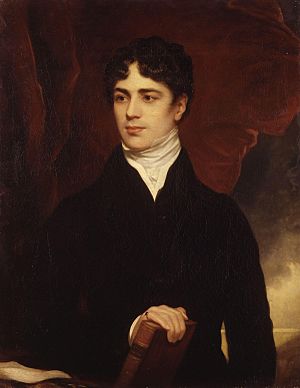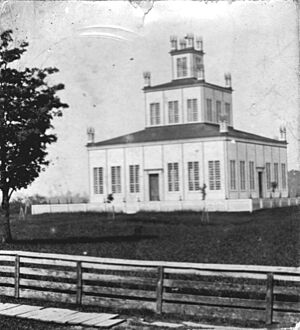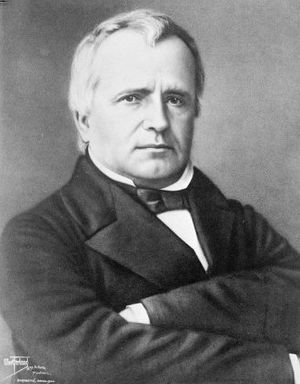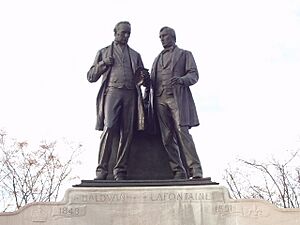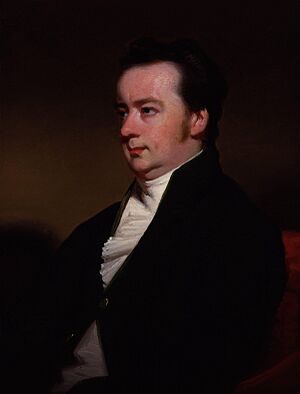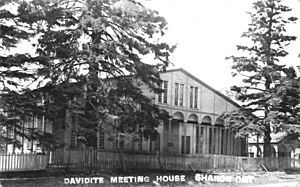Robert Baldwin facts for kids
Quick facts for kids
Robert Baldwin
|
|
|---|---|
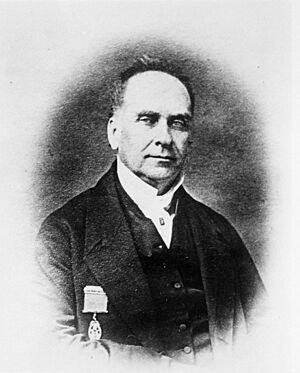 |
|
| Joint Premier of Province of Canada, for Canada West | |
| In office 1842–1843 |
|
| Preceded by | William Henry Draper |
| In office March 11, 1848 – June 21, 1851 |
|
| Succeeded by | Francis Hincks |
| Attorney General for Canada West | |
| In office September 17, 1842 – December 11, 1843 |
|
| Preceded by | William Henry Draper |
| Succeeded by | William Henry Draper |
| In office March 11, 1848 – June 21, 1851 |
|
| Preceded by | Henry Sherwood |
| Succeeded by | William Buell Richards |
| Member of the Parliament of the Province of Canada for Hastings, Canada West | |
| In office 1841–1842 |
|
| Preceded by | New position |
| Succeeded by | Edmund Murney |
| Member of the Parliament of the Province of Canada for Rimouski, Canada East | |
| In office 1843–1844 |
|
| Preceded by | Michel Borne |
| Succeeded by | Louis Bertrand |
| Personal details | |
| Born | May 12, 1804 York, Upper Canada |
| Died | December 9, 1858 (aged 54) Toronto, Canada West |
| Resting place | Spadina House (Baldwin family cemetery) |
| Political party | Reform movement |
| Spouses | Augusta Elizabeth Sullivan (May 3, 1827; her death, January 11, 1836) |
| Relatives | William Warren Baldwin (father) Frederick Walker Baldwin (grandson) Robert Baldwin Ross (grandson) |
| Profession | Lawyer |
| Signature | |
Robert Baldwin (born May 12, 1804 – died December 9, 1858) was a lawyer and politician from Upper Canada. He worked with his political partner Louis-Hippolyte Lafontaine from Lower Canada. Together, they led the first government in the Province of Canada that had "responsible government."
Responsible government meant that the province could govern itself democratically. This was achieved without a revolution, though there were some conflicts. Baldwin also helped create municipal governments, a modern legal system, and improved the jury system. He also helped end imprisonment for debt.
Contents
Family and Early Life
Robert Baldwin's family was important in Upper Canada. His grandfather, also named Robert Baldwin, moved to Upper Canada from Ireland in 1799. His father was William Warren Baldwin.
In 1827, Robert Baldwin married his cousin, Augusta Elizabeth Sullivan. They had four children. Augusta Elizabeth died in 1836. Robert Baldwin passed away 22 years later, in 1858.
Robert Baldwin was the grandfather of Frederick Walker Baldwin. Frederick was a Canadian aviation pioneer who worked with the famous inventor Alexander Graham Bell. Robert Baldwin was also the grandfather of Robert Baldwin Ross, a journalist and art critic.
Political Ideas and Goals
Robert Baldwin had strong political beliefs. He believed in civic duty, meaning citizens should participate in politics for the good of everyone. He thought that selfish people who put their own interests first were a threat to society.
What is Responsible Government?
The idea of "responsible government" is often linked to Robert Baldwin and his father, William W. Baldwin. This idea meant that the government leaders in the colony should be answerable to the elected parliament, not just to the British King or Queen's representative.
At first, the meaning of "responsible government" changed over time. By 1836, Baldwin believed that the Crown (the King's representative) should listen to its advisors. After the Rebellions of 1837, the idea became clearer. It meant that the government ministers were responsible to the elected assembly. This was a big step towards self-rule for Canada.
Local Government for Communities
Before Baldwin's time, local government in Upper Canada was run by appointed judges. These judges made laws for their areas. Some cities, like Toronto, had their own special rules.
After Upper and Lower Canada joined, the new governor, Lord Sydenham, created District Councils. These councils had some elected members, but the main leaders were still chosen by the government. This gave the government a lot of control.
Baldwin did not like this system. He wanted local governments to be truly democratic. In 1849, he helped pass the Baldwin Act. This law made local governments truly democratic. It allowed them to raise taxes and create their own local laws. It also set up different levels of local government, from cities down to townships. This system lasted for 150 years.
Robert Baldwin's Political Journey
Robert Baldwin was not a natural politician. He was described as quiet and sometimes awkward in public. He spoke in a soft, hesitant way. Even though he was elected in 1830, he lost the next election.
However, he was very committed to his beliefs. He was also brave, even when elections were rough. This earned him the trust of voters after the Rebellions.
Before the 1837 Rebellions
After losing his election in 1830, Baldwin focused on his law practice. He did not join the political reform movements of the 1830s. In 1836, a new Lieutenant Governor, Sir Francis Bond Head, arrived. He appointed Baldwin and other reformers to his Executive Council.
Baldwin agreed to join only if Bond Head promised to support responsible government. When Bond Head refused to put this in writing, Baldwin resigned. He convinced other council members to resign too. This made Bond Head angry, and he called an election. In this election, reformers lost many seats.
Baldwin traveled to Britain in 1836 to speak with the colonial secretary, Lord Glenelg. He told Glenelg that Britain could only keep the colony with the people's consent, not by force. He suggested responsible government as the solution. But his ideas were rejected, and the colony soon faced rebellion.
Robert Baldwin did not support the Upper Canada Rebellion of 1837–38. He tried to act as a peacemaker between the rebels and the government. He and his father advised Lord Durham to suggest responsible government to the British government.
Joining Upper and Lower Canada
After Lord Durham's report, the British government appointed Charles Poulett Thomson (Lord Sydenham) as Governor. His main goals were to unite Upper and Lower Canada and strengthen British rule. He wanted to limit the power of the elected assembly.
Sydenham changed the Executive Council. For the first time, government ministers became members. He asked Baldwin to be Solicitor General in 1840. To follow his principle of responsible government, Baldwin needed to be elected to the assembly. This way, he would be accountable to the people, not just the Crown.
Baldwin faced challenges winning elections in Toronto. He decided to run in Hastings and 4th York. A group called The Children of Peace helped Baldwin win the election in 4th York. He became one of the first members elected to the new United Parliament.
Baldwin and Lafontaine's Partnership
Reformers were a minority in the new parliament. In Canada East, it was hard for Louis-Hippolyte LaFontaine, the leader of the French-Canadian reformers, to win a seat. To help LaFontaine, Baldwin suggested that the Children of Peace nominate LaFontaine for the seat in 4th York. Baldwin also insisted that Governor Sydenham include LaFontaine in the Executive Council. If not, Baldwin would resign.
Their partnership helped LaFontaine get a seat in the assembly in 1841. On September 3, 1841, the Children of Peace held a rally for Baldwin and LaFontaine. Despite some threats, LaFontaine was elected to represent 4th York.
When Governor Sydenham died, Sir Charles Bagot became the new Governor. He had to include LaFontaine's group in his government. LaFontaine refused to join unless Baldwin was also included. Bagot finally agreed in September 1842. When Bagot became very ill, Baldwin and LaFontaine became the first true premiers of the Province of Canada.
To take office as ministers, they had to run for re-election. LaFontaine easily won his seat again. But Baldwin lost his seat in Hastings due to election issues. LaFontaine then arranged for Baldwin to run in Rimouski, a French-speaking area in Canada East. This showed the strong bond between the two men. LaFontaine, a French-speaker, won a seat in English Canada, and Baldwin, an English-speaker, won a seat in French Canada.
Challenges and Success
The Baldwin-LaFontaine government lasted only six months before Governor Bagot died. Sir Charles Metcalfe became the new Governor. He wanted to control the reform government. Baldwin and Metcalfe disagreed on many things. Metcalfe refused to approve Baldwin's bill to outlaw secret societies. He also started appointing people to jobs without Baldwin and LaFontaine's approval.
Baldwin and LaFontaine resigned in November 1843. This caused a political crisis that lasted a year. During this time, Metcalfe continued to govern, showing that Parliament was not always needed. Baldwin then created a "Reform Association" in February 1844. This group aimed to unite reformers and explain their idea of responsible government.
A large meeting of the Reform Association was held at the Second Meeting House of the Children of Peace in Sharon. This meeting helped Baldwin win his election in 4th York. LaFontaine, in another act of friendship, gave up his seat there so Baldwin could run. Over three thousand people attended the rally for Baldwin in June.
Responsible Government Achieved
In the next election, the Governor-General won by a small amount. But the year-long crisis made it clear that responsible government was coming. Even the old conservative politicians started to demand some form of responsible government.
Metcalfe continued to govern until he became ill in 1846. The new Governor-General, Lord Elgin, was sent to officially recognize responsible government in Canada. In 1848, the Reformers won power again. Baldwin and Lafontaine formed their second government on March 11. They made many important changes.
These changes included offering pardons to everyone involved in the Rebellions of 1837–38. They also created a public University of Toronto and introduced municipal government. Their bravest achievement was passing the Rebellion Losses Bill in 1849. This bill aimed to pay people in Lower Canada for damages during the rebellions. This caused anger among some groups and led to the burning of the Parliament buildings in Montreal.
Changes in the Reform Movement
The reformers led by Baldwin were not a single political party. Once their main goal of responsible government was achieved, disagreements started to appear. In 1851, Baldwin resigned. One reason was a vote to abolish the Court of Chancery, which Baldwin had helped create. Even though the attempt failed, most representatives from Upper Canada supported it. Baldwin felt this was a vote of no confidence.
A deeper reason was that Baldwin did not agree with the more extreme views of the "Clear Grits," a new group of reformers. When he ran for re-election in York, he refused to promise anything about the Clergy Reserves, a big issue at the time. He was defeated.
Robert Baldwin died on December 9, 1858, at his home, Spadina House, at age 54. Even those who disagreed with him admitted he had pure and selfless motives. After responsible government was granted, he worked to create a good relationship between English and French-speaking Canadians. He is remembered fondly by both French Canadians and people in his home province of Ontario.
Legacy
John Ralston Saul noted that Canada has had very little political violence compared to other countries. He said that this peaceful tradition is thanks to Robert Baldwin and Louis-Hippolyte LaFontaine. They refused to seek revenge and stuck to their principles.
The Baldwin Steps, a series of stairs near his father's home at Spadina House, are named after Baldwin.
See also
 In Spanish: Robert Baldwin para niños
In Spanish: Robert Baldwin para niños


